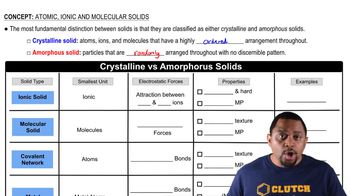The coordination number for the Al3+ ion is typically between four and six. Use the anion coordination number to determine the Al3 + coordination number in the following compounds: (b) Al2O3 where the oxygen ions are six coordinate.
Ch.12 - Solids and Modern Materials
Chapter 12, Problem 68
Classify each of the following statements as true or false: (a) For molecular solids, the melting point generally increases as the strengths of the covalent bonds increase. (b) For molecular solids, the melting point generally increases as the strengths of the intermolecular forces increase.
 Verified step by step guidance
Verified step by step guidance1
Step 1: Understand the difference between covalent bonds and intermolecular forces. Covalent bonds are the strong bonds that hold atoms together within a molecule, while intermolecular forces are weaker forces that occur between molecules.
Step 2: Analyze statement (a). In molecular solids, the molecules are held together by intermolecular forces, not covalent bonds. Therefore, the melting point is not directly related to the strength of covalent bonds within the molecules.
Step 3: Determine the truth of statement (a). Since the melting point of molecular solids is not dependent on the strength of covalent bonds, statement (a) is false.
Step 4: Analyze statement (b). The melting point of molecular solids is influenced by the strength of intermolecular forces. Stronger intermolecular forces require more energy to overcome, leading to a higher melting point.
Step 5: Determine the truth of statement (b). Since the melting point generally increases with stronger intermolecular forces, statement (b) is true.
Key Concepts
Here are the essential concepts you must grasp in order to answer the question correctly.
Molecular Solids
Molecular solids are composed of molecules held together by intermolecular forces such as van der Waals forces, dipole-dipole interactions, and hydrogen bonds. Unlike ionic or metallic solids, molecular solids have relatively lower melting and boiling points due to the weaker nature of these forces compared to covalent or ionic bonds. Understanding the structure and bonding in molecular solids is crucial for predicting their physical properties.
Recommended video:
Guided course

Crystalline vs Amorphous Solids
Intermolecular Forces
Intermolecular forces are the attractive forces between molecules that influence the physical properties of substances, including melting and boiling points. These forces vary in strength, with hydrogen bonds being the strongest, followed by dipole-dipole interactions and London dispersion forces. The strength of these forces directly affects the melting point of molecular solids, as stronger intermolecular forces lead to higher melting points.
Recommended video:
Guided course

Intermolecular vs Intramolecular Forces
Covalent Bonds vs. Intermolecular Forces
Covalent bonds are strong chemical bonds formed by the sharing of electrons between atoms, resulting in the formation of molecules. In contrast, intermolecular forces are weaker interactions that occur between molecules. While the strength of covalent bonds affects the stability of the molecules themselves, it is the strength of the intermolecular forces that primarily determines the melting point of molecular solids.
Recommended video:
Guided course

Intermolecular vs Intramolecular Forces
Related Practice
Textbook Question
Textbook Question
The coordination number for the Al3+ ion is typically between four and six. Use the anion coordination number to determine the Al3 + coordination number in the following compounds: (c) AlN where the nitride ions are four coordinate.
Textbook Question
Both covalent-network solids and ionic solids can have melting points well in excess of room temperature, and both can be poor conductors of electricity in their pure form. However, in other ways their properties are quite different. (a) Which type of solid is more likely to dissolve in water?
Textbook Question
For each of the following pairs of semiconductors, which one will have the larger band gap: (a) CdS or CdTe? (b) GaN or InP? (c) GaAs or InAs?
